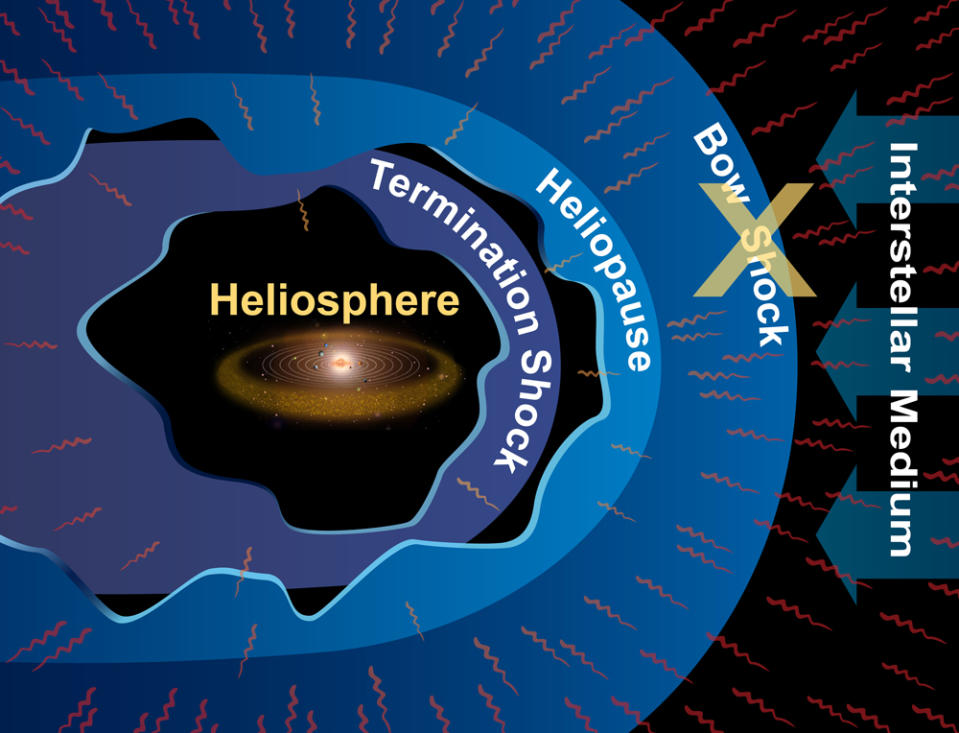Scientists believe Earth may have briefly lost its protection from the sun about two million years ago, left to endure the extreme environment of interstellar space, as the solar system passed through a dense cloud of gas and dust between stars.
At that time, early human ancestors shared our planet with prehistoric animals such as mastodons and saber-toothed tigers. This was also when Earth was in the midst of an ice age that ended only 12,000 years ago. Ice ages are caused by a variety of factors, including our planet’s tilt and rotation, carbon dioxide levels in its atmosphere, changing plate tectonics, and volcanic eruptions on its surface. However, given the timing at which scientists think Earth fell into interstellar space, this research suggests that radical changes in our planet’s climate, such as the beginning and end of ice ages, may also be influenced by our solar system’s location in our home galaxy.
More specifically, the team behind the new findings suggests that the solar system may have encountered a dense mass of interstellar gas and dust as it crossed the Milky Way two million years ago. And this patch may be thick enough to interfere with the flow of charged particles called the “solar wind” that flow from the sun and impact Earth, potentially causing temperatures to drop.
Relating to: ‘Hand of God’ interstellar cloud reaches stars in new Dark Energy Camera image (video)
“This paper is the first to show quantitatively that there is an encounter between the sun and something outside the solar system that could affect Earth’s climate,” said study lead author Merav Opher, a space physicist and heliosphere expert at Boston University. In a statement.
Solar system, back in time
Our entire solar system is surrounded by a “giant protective bubble of plasma” from the sun, known as the “heliosphere”. This protective shield is created when solar winds press on the interstellar medium; This refers to matter drifting in the spaces between stars in the Milky Way. The heliosphere is constantly replenished by the constant stream of charged particles from the sun flowing outward past Pluto.
The heliosphere protects the Earth’s surface from radiation and galactic rays that could potentially affect the DNA of living things. This protection is so vital that many scientists believe it was integral to the emergence and evolution of life on Earth.
This team thinks that a cold cloud of interstellar matter may have once blocked the solar wind in a way that compressed the heliosphere. This may have briefly (in a cosmic sense) removed Earth and other solar system planets from the protection offered by the heliosphere.
“Stars are moving, and this paper shows that not only are they moving, but they are also experiencing drastic changes,” Opher said. he added.

Opher turned back the clock with advanced computer models to determine the impact on Earth of such an intense bombardment of interstellar dust into the heliosphere. This allowed him and his team to visualize where the sun was positioned two million years ago and also determine where the heliosphere and the rest of the solar system were at this time.
They also tracked a series of dense cold gases called the “Local Ribbon of Cold Clouds system” moving backwards in time as they passed through the Milky Way. This revealed that a dense cloud at the tail end of the Local Cold Cloud Ribbon system, called the “Local Lynx of the Cold Cloud”, may have collided with the heliosphere.
This would expose Earth to the interstellar medium, including heavy and radioactive elements living within it, which are the remnants of massive stars that died in supernova explosions. The heliosphere generally blocks these particles; Without this protection, these radioactive elements could rain down on Earth. This could explain the increase in the isotopes iron 60 and plutonium 244 in Antarctica’s snow and ice cores and on the moon corresponding to a period two million years ago. The timing of the heliosphere’s collision with the Local Lynx of the Cold Cloud also corresponds to the cooling period of the Earth two million years ago.
Opher theorizes that pressure from the Native Lynx of the Cold Cloud may have restricted the heliosphere for periods as short as a few hundred years or as long as a million years. This will all depend on how big the cloud actually is, Opher said. He added that after the effect of this dense cloud disappears, the heliosphere will grow again and surround the planets.
Related Stories:
— Pulsar surprises astronomers with record-breaking gamma rays
— Massive astronomical survey reveals 3.3 billion Milky Way objects
— Dark Energy Camera peels back layers of ‘galactic onion’ across space
But for now, it’s difficult to pinpoint the impact this cold interstellar cloud will have on Earth, including whether it could actually start an ice age. The team will now search further back in time to find other times when the solar system intersected with dense interstellar clouds and determine whether these aligned with ice ages.
He and his team are also currently investigating the impact of so much hydrogen and radioactive material intersecting the Earth’s atmosphere.
“This cloud was indeed in our past, and if we passed over something that big, we would be exposed to the interstellar medium,” Opher said. “This is just the beginning.”
The team’s research was published Monday, June 10, in Nature Astronomy.